Leading a Team: Analyzing Team Management and Leadership at Tesco
VerifiedAdded on 2019/12/18
|12
|3649
|180
Report
AI Summary
This report delves into the critical aspects of leading teams, focusing on the input-throughput-output process within organizations. It examines team formation using the Tuckman model, exploring the stages of forming, storming, norming, and performing. The report analyzes various leadership theories, including situational, systematic, contingency, and behavioral approaches, offering insights into their application in diverse organizational contexts, particularly referencing the case of Tesco. Furthermore, it emphasizes the importance of teamwork, highlighting its benefits for both the organization and individual team members, and addresses conflict management strategies. The report provides a comprehensive overview of team dynamics, leadership styles, and their impact on achieving organizational objectives, making it a valuable resource for understanding effective team management principles.
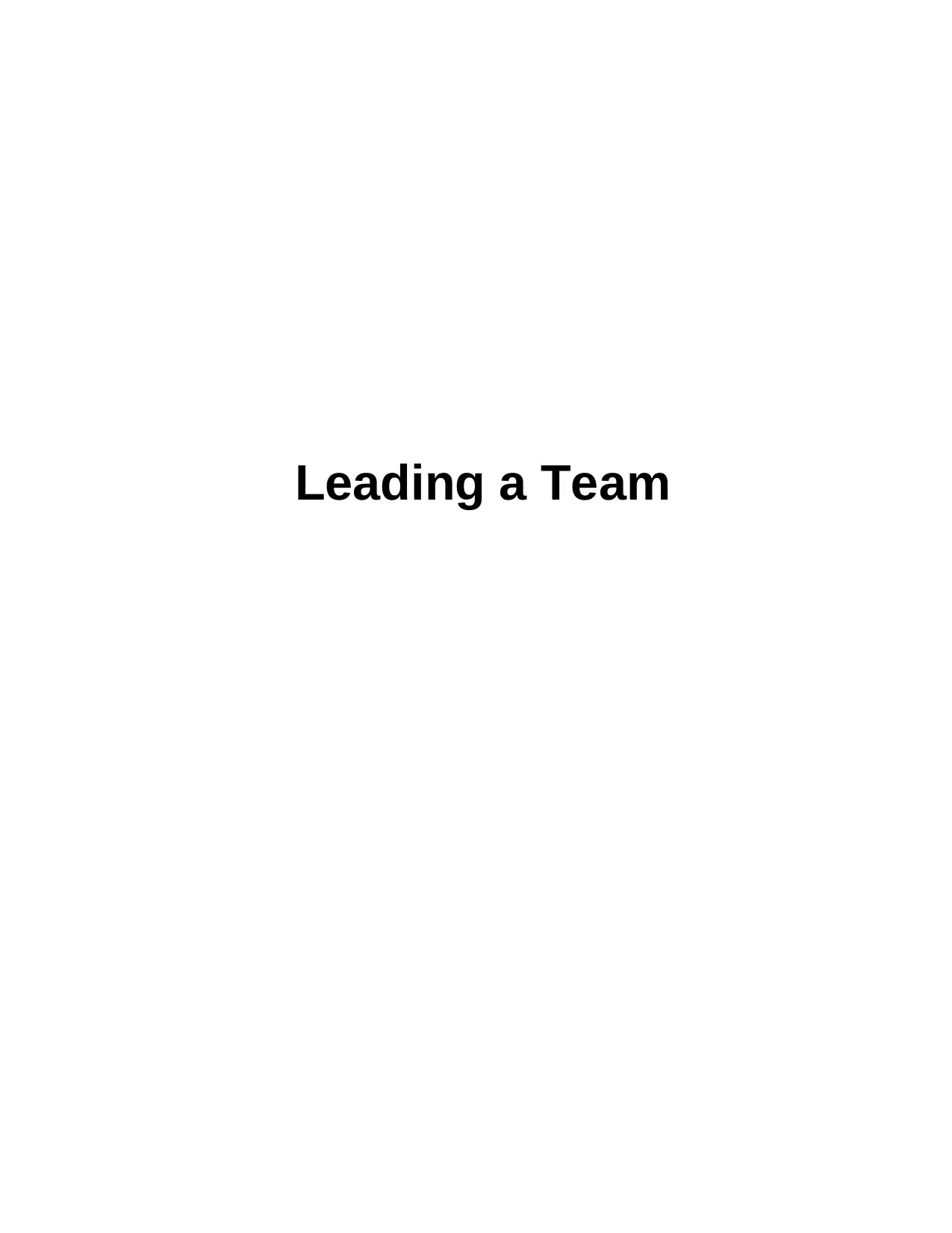
Leading a Team
Paraphrase This Document
Need a fresh take? Get an instant paraphrase of this document with our AI Paraphraser
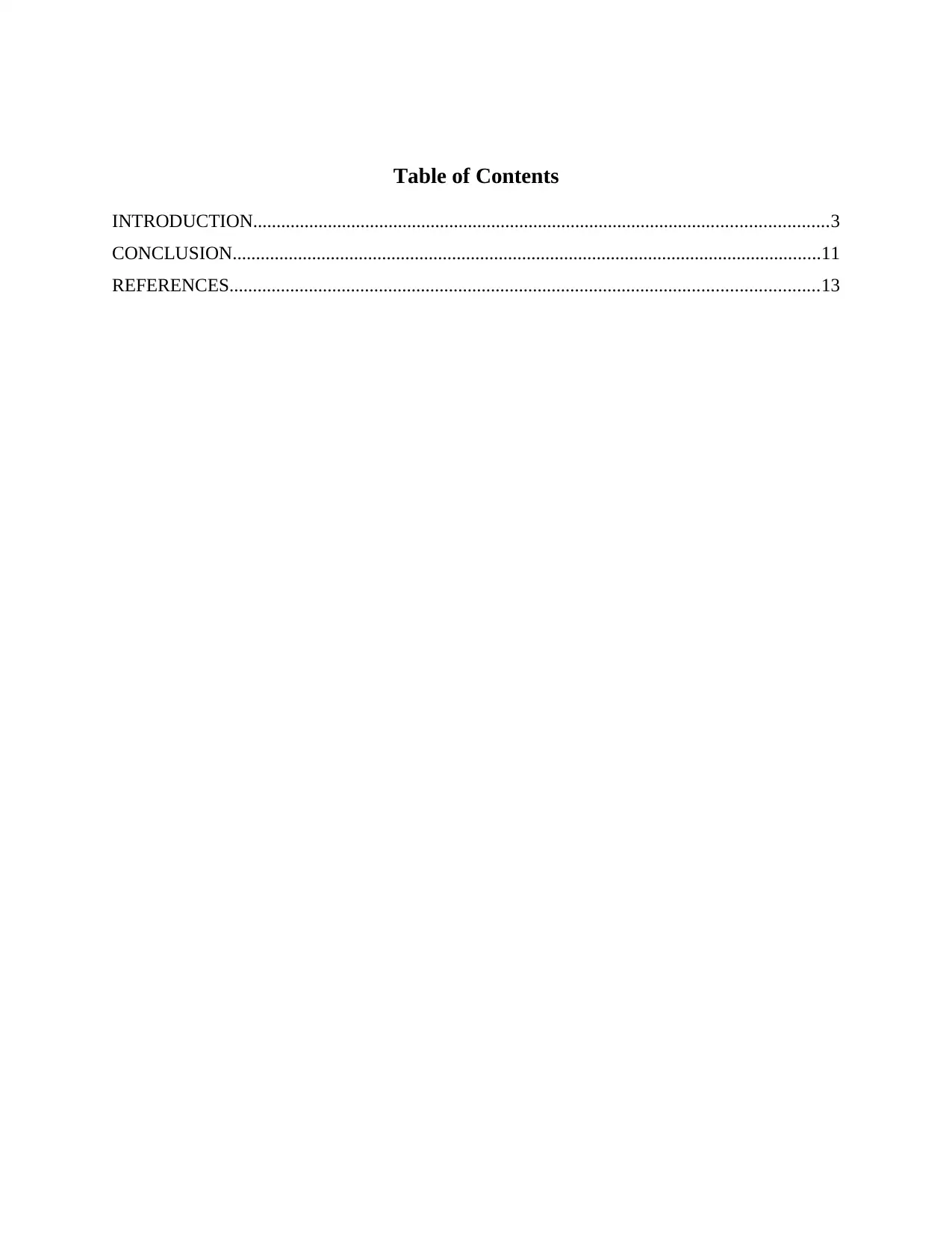
Table of Contents
INTRODUCTION...........................................................................................................................3
CONCLUSION..............................................................................................................................11
REFERENCES..............................................................................................................................13
INTRODUCTION...........................................................................................................................3
CONCLUSION..............................................................................................................................11
REFERENCES..............................................................................................................................13
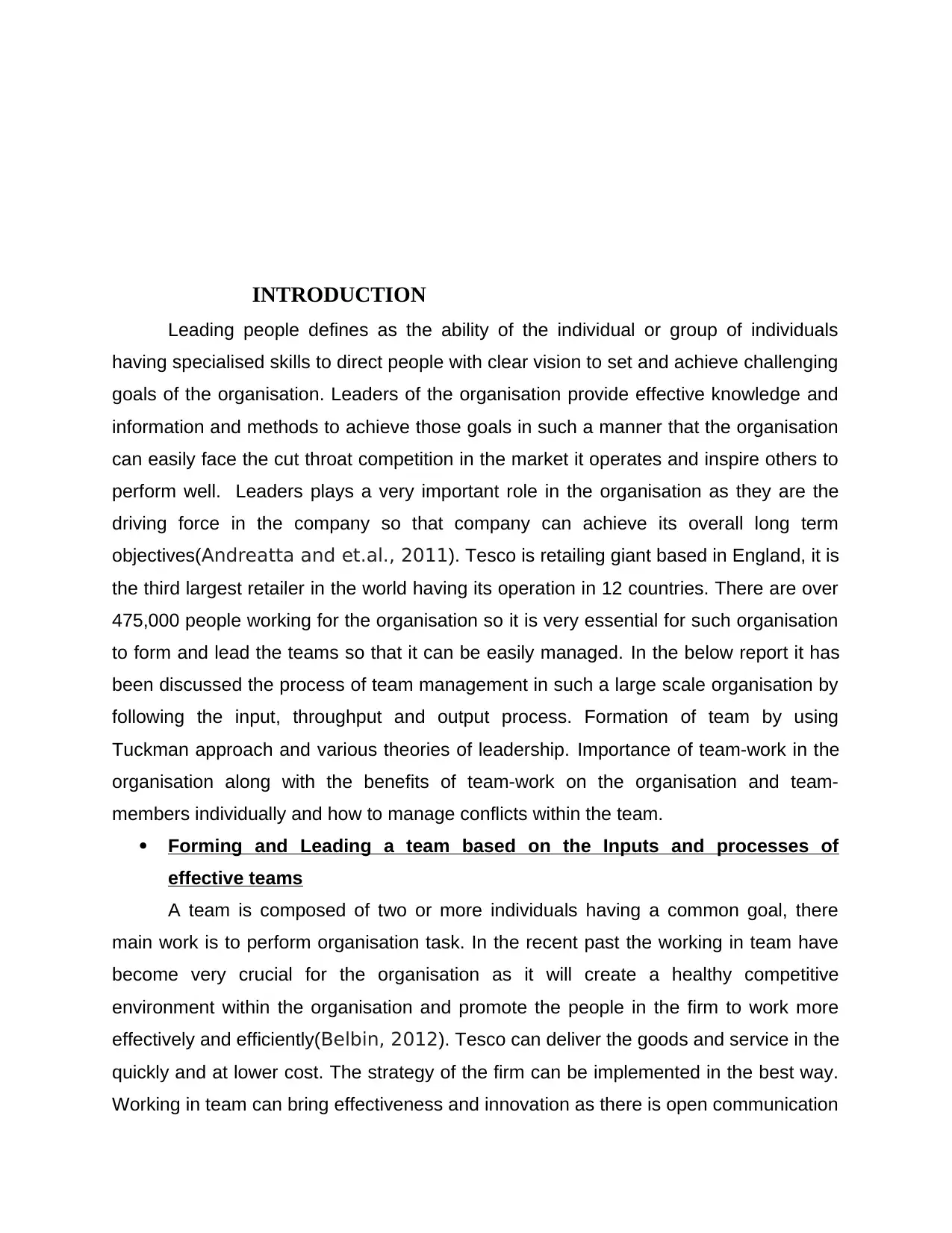
INTRODUCTION
Leading people defines as the ability of the individual or group of individuals
having specialised skills to direct people with clear vision to set and achieve challenging
goals of the organisation. Leaders of the organisation provide effective knowledge and
information and methods to achieve those goals in such a manner that the organisation
can easily face the cut throat competition in the market it operates and inspire others to
perform well. Leaders plays a very important role in the organisation as they are the
driving force in the company so that company can achieve its overall long term
objectives(Andreatta and et.al., 2011). Tesco is retailing giant based in England, it is
the third largest retailer in the world having its operation in 12 countries. There are over
475,000 people working for the organisation so it is very essential for such organisation
to form and lead the teams so that it can be easily managed. In the below report it has
been discussed the process of team management in such a large scale organisation by
following the input, throughput and output process. Formation of team by using
Tuckman approach and various theories of leadership. Importance of team-work in the
organisation along with the benefits of team-work on the organisation and team-
members individually and how to manage conflicts within the team.
Forming and Leading a team based on the Inputs and processes of
effective teams
A team is composed of two or more individuals having a common goal, there
main work is to perform organisation task. In the recent past the working in team have
become very crucial for the organisation as it will create a healthy competitive
environment within the organisation and promote the people in the firm to work more
effectively and efficiently(Belbin, 2012). Tesco can deliver the goods and service in the
quickly and at lower cost. The strategy of the firm can be implemented in the best way.
Working in team can bring effectiveness and innovation as there is open communication
Leading people defines as the ability of the individual or group of individuals
having specialised skills to direct people with clear vision to set and achieve challenging
goals of the organisation. Leaders of the organisation provide effective knowledge and
information and methods to achieve those goals in such a manner that the organisation
can easily face the cut throat competition in the market it operates and inspire others to
perform well. Leaders plays a very important role in the organisation as they are the
driving force in the company so that company can achieve its overall long term
objectives(Andreatta and et.al., 2011). Tesco is retailing giant based in England, it is
the third largest retailer in the world having its operation in 12 countries. There are over
475,000 people working for the organisation so it is very essential for such organisation
to form and lead the teams so that it can be easily managed. In the below report it has
been discussed the process of team management in such a large scale organisation by
following the input, throughput and output process. Formation of team by using
Tuckman approach and various theories of leadership. Importance of team-work in the
organisation along with the benefits of team-work on the organisation and team-
members individually and how to manage conflicts within the team.
Forming and Leading a team based on the Inputs and processes of
effective teams
A team is composed of two or more individuals having a common goal, there
main work is to perform organisation task. In the recent past the working in team have
become very crucial for the organisation as it will create a healthy competitive
environment within the organisation and promote the people in the firm to work more
effectively and efficiently(Belbin, 2012). Tesco can deliver the goods and service in the
quickly and at lower cost. The strategy of the firm can be implemented in the best way.
Working in team can bring effectiveness and innovation as there is open communication
⊘ This is a preview!⊘
Do you want full access?
Subscribe today to unlock all pages.

Trusted by 1+ million students worldwide
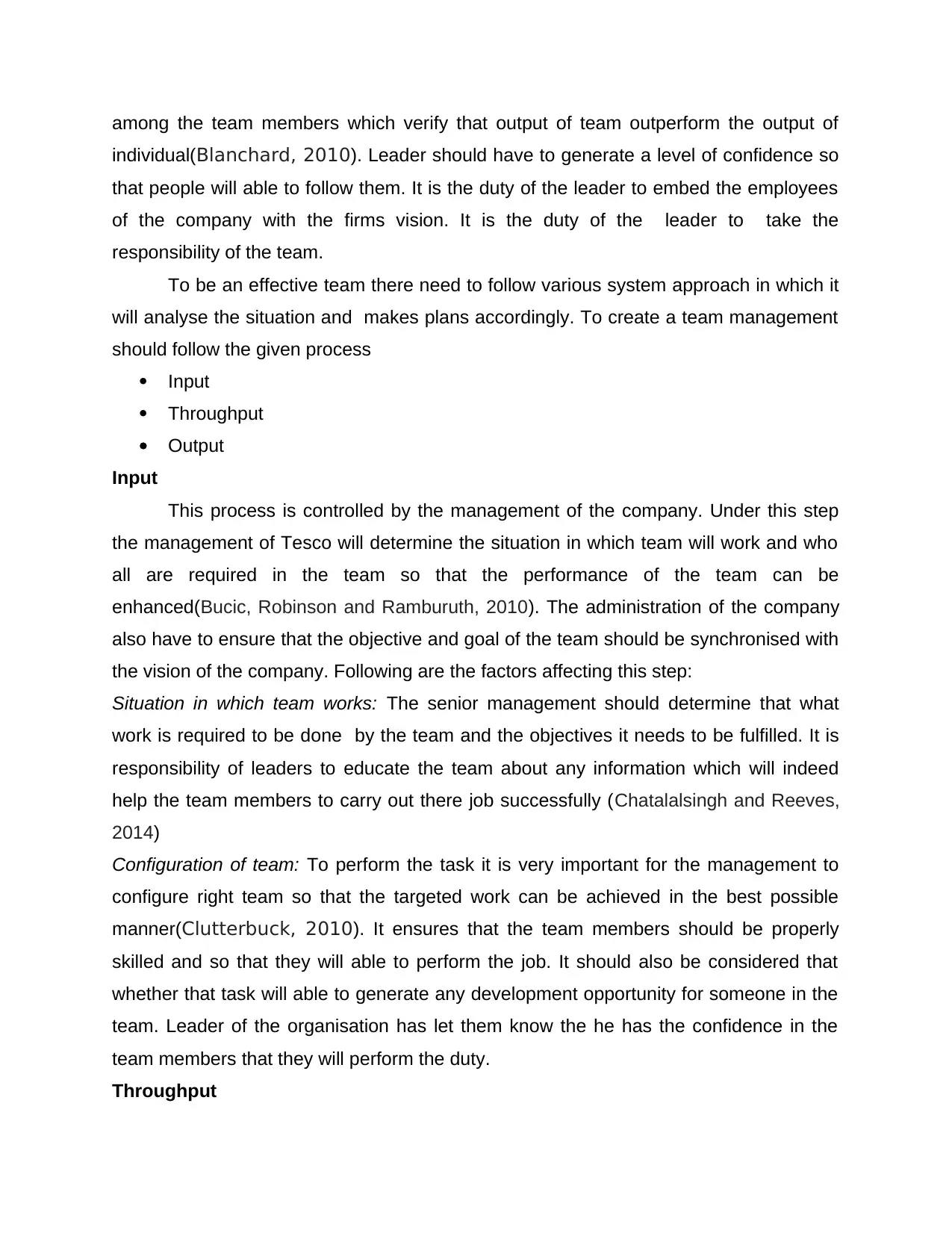
among the team members which verify that output of team outperform the output of
individual(Blanchard, 2010). Leader should have to generate a level of confidence so
that people will able to follow them. It is the duty of the leader to embed the employees
of the company with the firms vision. It is the duty of the leader to take the
responsibility of the team.
To be an effective team there need to follow various system approach in which it
will analyse the situation and makes plans accordingly. To create a team management
should follow the given process
Input
Throughput
Output
Input
This process is controlled by the management of the company. Under this step
the management of Tesco will determine the situation in which team will work and who
all are required in the team so that the performance of the team can be
enhanced(Bucic, Robinson and Ramburuth, 2010). The administration of the company
also have to ensure that the objective and goal of the team should be synchronised with
the vision of the company. Following are the factors affecting this step:
Situation in which team works: The senior management should determine that what
work is required to be done by the team and the objectives it needs to be fulfilled. It is
responsibility of leaders to educate the team about any information which will indeed
help the team members to carry out there job successfully (Chatalalsingh and Reeves,
2014)
Configuration of team: To perform the task it is very important for the management to
configure right team so that the targeted work can be achieved in the best possible
manner(Clutterbuck, 2010). It ensures that the team members should be properly
skilled and so that they will able to perform the job. It should also be considered that
whether that task will able to generate any development opportunity for someone in the
team. Leader of the organisation has let them know the he has the confidence in the
team members that they will perform the duty.
Throughput
individual(Blanchard, 2010). Leader should have to generate a level of confidence so
that people will able to follow them. It is the duty of the leader to embed the employees
of the company with the firms vision. It is the duty of the leader to take the
responsibility of the team.
To be an effective team there need to follow various system approach in which it
will analyse the situation and makes plans accordingly. To create a team management
should follow the given process
Input
Throughput
Output
Input
This process is controlled by the management of the company. Under this step
the management of Tesco will determine the situation in which team will work and who
all are required in the team so that the performance of the team can be
enhanced(Bucic, Robinson and Ramburuth, 2010). The administration of the company
also have to ensure that the objective and goal of the team should be synchronised with
the vision of the company. Following are the factors affecting this step:
Situation in which team works: The senior management should determine that what
work is required to be done by the team and the objectives it needs to be fulfilled. It is
responsibility of leaders to educate the team about any information which will indeed
help the team members to carry out there job successfully (Chatalalsingh and Reeves,
2014)
Configuration of team: To perform the task it is very important for the management to
configure right team so that the targeted work can be achieved in the best possible
manner(Clutterbuck, 2010). It ensures that the team members should be properly
skilled and so that they will able to perform the job. It should also be considered that
whether that task will able to generate any development opportunity for someone in the
team. Leader of the organisation has let them know the he has the confidence in the
team members that they will perform the duty.
Throughput
Paraphrase This Document
Need a fresh take? Get an instant paraphrase of this document with our AI Paraphraser
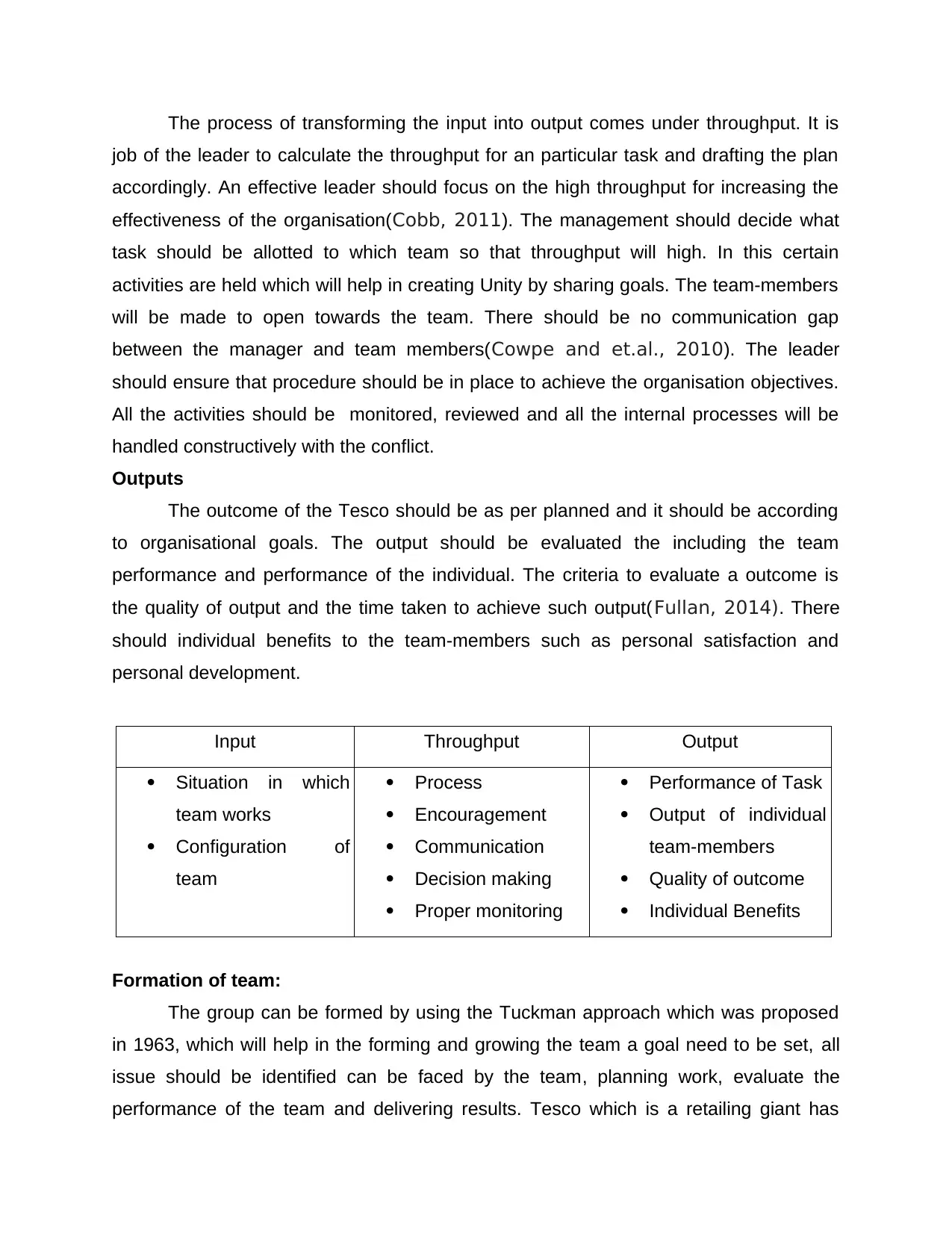
The process of transforming the input into output comes under throughput. It is
job of the leader to calculate the throughput for an particular task and drafting the plan
accordingly. An effective leader should focus on the high throughput for increasing the
effectiveness of the organisation(Cobb, 2011). The management should decide what
task should be allotted to which team so that throughput will high. In this certain
activities are held which will help in creating Unity by sharing goals. The team-members
will be made to open towards the team. There should be no communication gap
between the manager and team members(Cowpe and et.al., 2010). The leader
should ensure that procedure should be in place to achieve the organisation objectives.
All the activities should be monitored, reviewed and all the internal processes will be
handled constructively with the conflict.
Outputs
The outcome of the Tesco should be as per planned and it should be according
to organisational goals. The output should be evaluated the including the team
performance and performance of the individual. The criteria to evaluate a outcome is
the quality of output and the time taken to achieve such output(Fullan, 2014). There
should individual benefits to the team-members such as personal satisfaction and
personal development.
Input Throughput Output
Situation in which
team works
Configuration of
team
Process
Encouragement
Communication
Decision making
Proper monitoring
Performance of Task
Output of individual
team-members
Quality of outcome
Individual Benefits
Formation of team:
The group can be formed by using the Tuckman approach which was proposed
in 1963, which will help in the forming and growing the team a goal need to be set, all
issue should be identified can be faced by the team, planning work, evaluate the
performance of the team and delivering results. Tesco which is a retailing giant has
job of the leader to calculate the throughput for an particular task and drafting the plan
accordingly. An effective leader should focus on the high throughput for increasing the
effectiveness of the organisation(Cobb, 2011). The management should decide what
task should be allotted to which team so that throughput will high. In this certain
activities are held which will help in creating Unity by sharing goals. The team-members
will be made to open towards the team. There should be no communication gap
between the manager and team members(Cowpe and et.al., 2010). The leader
should ensure that procedure should be in place to achieve the organisation objectives.
All the activities should be monitored, reviewed and all the internal processes will be
handled constructively with the conflict.
Outputs
The outcome of the Tesco should be as per planned and it should be according
to organisational goals. The output should be evaluated the including the team
performance and performance of the individual. The criteria to evaluate a outcome is
the quality of output and the time taken to achieve such output(Fullan, 2014). There
should individual benefits to the team-members such as personal satisfaction and
personal development.
Input Throughput Output
Situation in which
team works
Configuration of
team
Process
Encouragement
Communication
Decision making
Proper monitoring
Performance of Task
Output of individual
team-members
Quality of outcome
Individual Benefits
Formation of team:
The group can be formed by using the Tuckman approach which was proposed
in 1963, which will help in the forming and growing the team a goal need to be set, all
issue should be identified can be faced by the team, planning work, evaluate the
performance of the team and delivering results. Tesco which is a retailing giant has
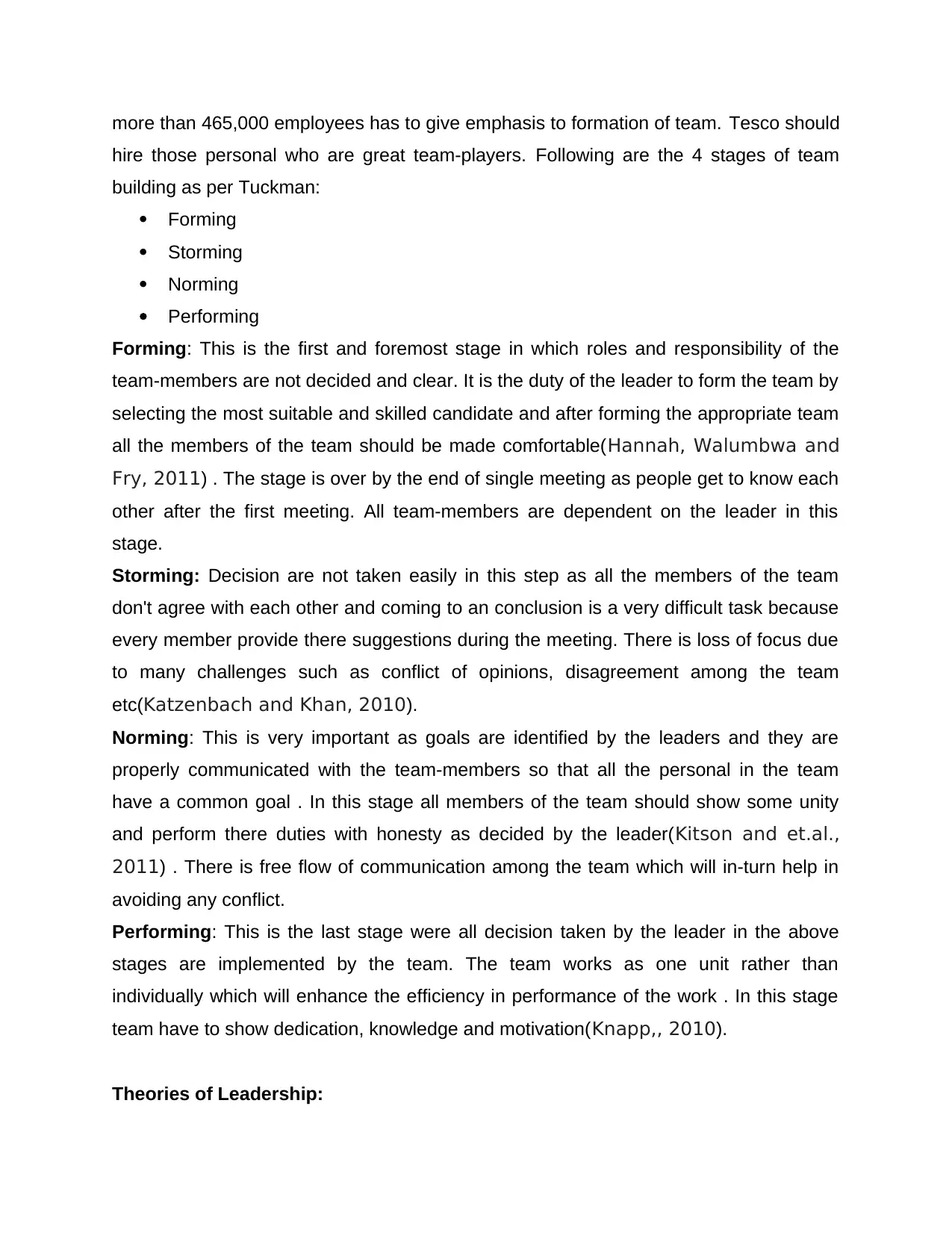
more than 465,000 employees has to give emphasis to formation of team. Tesco should
hire those personal who are great team-players. Following are the 4 stages of team
building as per Tuckman:
Forming
Storming
Norming
Performing
Forming: This is the first and foremost stage in which roles and responsibility of the
team-members are not decided and clear. It is the duty of the leader to form the team by
selecting the most suitable and skilled candidate and after forming the appropriate team
all the members of the team should be made comfortable(Hannah, Walumbwa and
Fry, 2011) . The stage is over by the end of single meeting as people get to know each
other after the first meeting. All team-members are dependent on the leader in this
stage.
Storming: Decision are not taken easily in this step as all the members of the team
don't agree with each other and coming to an conclusion is a very difficult task because
every member provide there suggestions during the meeting. There is loss of focus due
to many challenges such as conflict of opinions, disagreement among the team
etc(Katzenbach and Khan, 2010).
Norming: This is very important as goals are identified by the leaders and they are
properly communicated with the team-members so that all the personal in the team
have a common goal . In this stage all members of the team should show some unity
and perform there duties with honesty as decided by the leader(Kitson and et.al.,
2011) . There is free flow of communication among the team which will in-turn help in
avoiding any conflict.
Performing: This is the last stage were all decision taken by the leader in the above
stages are implemented by the team. The team works as one unit rather than
individually which will enhance the efficiency in performance of the work . In this stage
team have to show dedication, knowledge and motivation(Knapp,, 2010).
Theories of Leadership:
hire those personal who are great team-players. Following are the 4 stages of team
building as per Tuckman:
Forming
Storming
Norming
Performing
Forming: This is the first and foremost stage in which roles and responsibility of the
team-members are not decided and clear. It is the duty of the leader to form the team by
selecting the most suitable and skilled candidate and after forming the appropriate team
all the members of the team should be made comfortable(Hannah, Walumbwa and
Fry, 2011) . The stage is over by the end of single meeting as people get to know each
other after the first meeting. All team-members are dependent on the leader in this
stage.
Storming: Decision are not taken easily in this step as all the members of the team
don't agree with each other and coming to an conclusion is a very difficult task because
every member provide there suggestions during the meeting. There is loss of focus due
to many challenges such as conflict of opinions, disagreement among the team
etc(Katzenbach and Khan, 2010).
Norming: This is very important as goals are identified by the leaders and they are
properly communicated with the team-members so that all the personal in the team
have a common goal . In this stage all members of the team should show some unity
and perform there duties with honesty as decided by the leader(Kitson and et.al.,
2011) . There is free flow of communication among the team which will in-turn help in
avoiding any conflict.
Performing: This is the last stage were all decision taken by the leader in the above
stages are implemented by the team. The team works as one unit rather than
individually which will enhance the efficiency in performance of the work . In this stage
team have to show dedication, knowledge and motivation(Knapp,, 2010).
Theories of Leadership:
⊘ This is a preview!⊘
Do you want full access?
Subscribe today to unlock all pages.

Trusted by 1+ million students worldwide
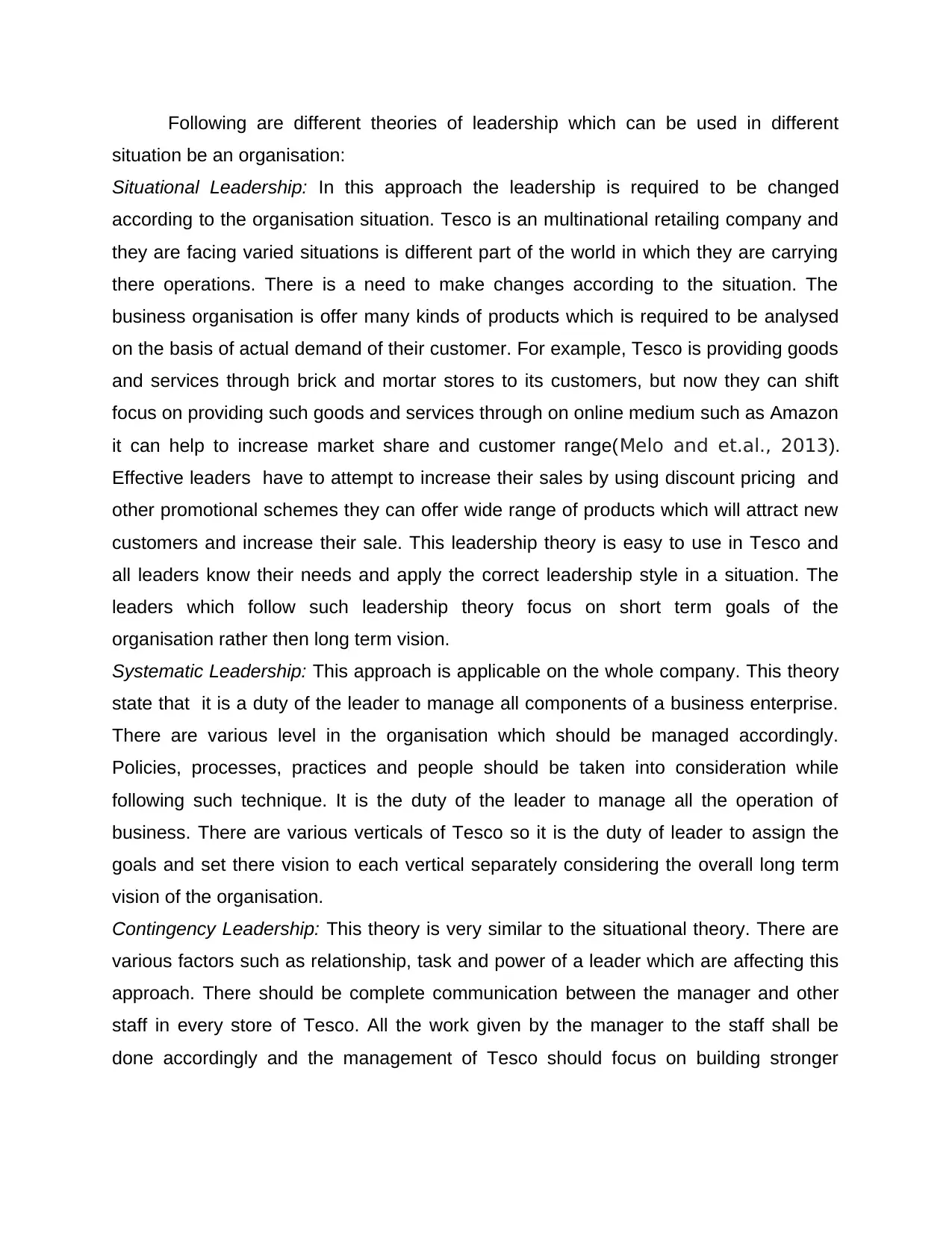
Following are different theories of leadership which can be used in different
situation be an organisation:
Situational Leadership: In this approach the leadership is required to be changed
according to the organisation situation. Tesco is an multinational retailing company and
they are facing varied situations is different part of the world in which they are carrying
there operations. There is a need to make changes according to the situation. The
business organisation is offer many kinds of products which is required to be analysed
on the basis of actual demand of their customer. For example, Tesco is providing goods
and services through brick and mortar stores to its customers, but now they can shift
focus on providing such goods and services through on online medium such as Amazon
it can help to increase market share and customer range(Melo and et.al., 2013).
Effective leaders have to attempt to increase their sales by using discount pricing and
other promotional schemes they can offer wide range of products which will attract new
customers and increase their sale. This leadership theory is easy to use in Tesco and
all leaders know their needs and apply the correct leadership style in a situation. The
leaders which follow such leadership theory focus on short term goals of the
organisation rather then long term vision.
Systematic Leadership: This approach is applicable on the whole company. This theory
state that it is a duty of the leader to manage all components of a business enterprise.
There are various level in the organisation which should be managed accordingly.
Policies, processes, practices and people should be taken into consideration while
following such technique. It is the duty of the leader to manage all the operation of
business. There are various verticals of Tesco so it is the duty of leader to assign the
goals and set there vision to each vertical separately considering the overall long term
vision of the organisation.
Contingency Leadership: This theory is very similar to the situational theory. There are
various factors such as relationship, task and power of a leader which are affecting this
approach. There should be complete communication between the manager and other
staff in every store of Tesco. All the work given by the manager to the staff shall be
done accordingly and the management of Tesco should focus on building stronger
situation be an organisation:
Situational Leadership: In this approach the leadership is required to be changed
according to the organisation situation. Tesco is an multinational retailing company and
they are facing varied situations is different part of the world in which they are carrying
there operations. There is a need to make changes according to the situation. The
business organisation is offer many kinds of products which is required to be analysed
on the basis of actual demand of their customer. For example, Tesco is providing goods
and services through brick and mortar stores to its customers, but now they can shift
focus on providing such goods and services through on online medium such as Amazon
it can help to increase market share and customer range(Melo and et.al., 2013).
Effective leaders have to attempt to increase their sales by using discount pricing and
other promotional schemes they can offer wide range of products which will attract new
customers and increase their sale. This leadership theory is easy to use in Tesco and
all leaders know their needs and apply the correct leadership style in a situation. The
leaders which follow such leadership theory focus on short term goals of the
organisation rather then long term vision.
Systematic Leadership: This approach is applicable on the whole company. This theory
state that it is a duty of the leader to manage all components of a business enterprise.
There are various level in the organisation which should be managed accordingly.
Policies, processes, practices and people should be taken into consideration while
following such technique. It is the duty of the leader to manage all the operation of
business. There are various verticals of Tesco so it is the duty of leader to assign the
goals and set there vision to each vertical separately considering the overall long term
vision of the organisation.
Contingency Leadership: This theory is very similar to the situational theory. There are
various factors such as relationship, task and power of a leader which are affecting this
approach. There should be complete communication between the manager and other
staff in every store of Tesco. All the work given by the manager to the staff shall be
done accordingly and the management of Tesco should focus on building stronger
Paraphrase This Document
Need a fresh take? Get an instant paraphrase of this document with our AI Paraphraser
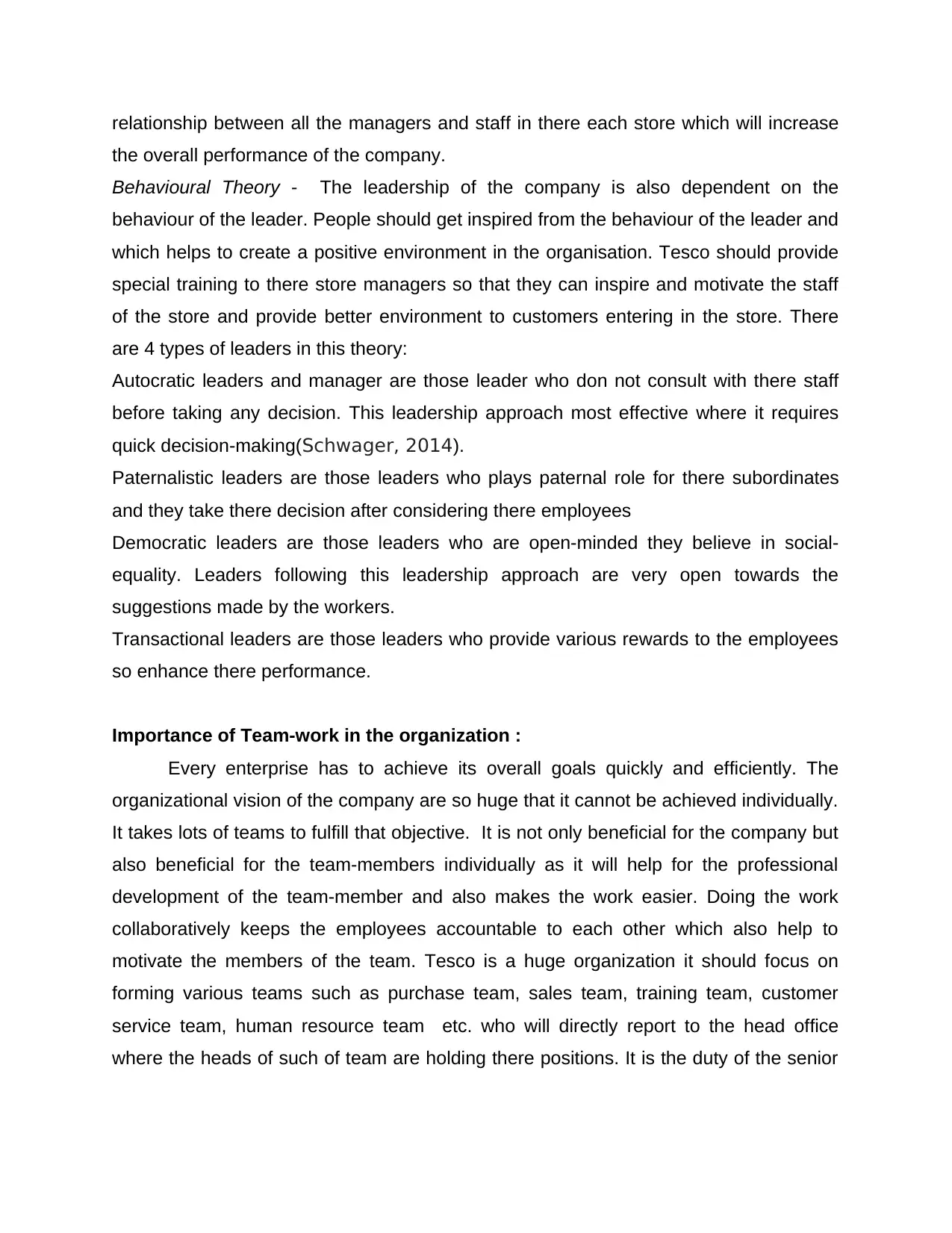
relationship between all the managers and staff in there each store which will increase
the overall performance of the company.
Behavioural Theory - The leadership of the company is also dependent on the
behaviour of the leader. People should get inspired from the behaviour of the leader and
which helps to create a positive environment in the organisation. Tesco should provide
special training to there store managers so that they can inspire and motivate the staff
of the store and provide better environment to customers entering in the store. There
are 4 types of leaders in this theory:
Autocratic leaders and manager are those leader who don not consult with there staff
before taking any decision. This leadership approach most effective where it requires
quick decision-making(Schwager, 2014).
Paternalistic leaders are those leaders who plays paternal role for there subordinates
and they take there decision after considering there employees
Democratic leaders are those leaders who are open-minded they believe in social-
equality. Leaders following this leadership approach are very open towards the
suggestions made by the workers.
Transactional leaders are those leaders who provide various rewards to the employees
so enhance there performance.
Importance of Team-work in the organization :
Every enterprise has to achieve its overall goals quickly and efficiently. The
organizational vision of the company are so huge that it cannot be achieved individually.
It takes lots of teams to fulfill that objective. It is not only beneficial for the company but
also beneficial for the team-members individually as it will help for the professional
development of the team-member and also makes the work easier. Doing the work
collaboratively keeps the employees accountable to each other which also help to
motivate the members of the team. Tesco is a huge organization it should focus on
forming various teams such as purchase team, sales team, training team, customer
service team, human resource team etc. who will directly report to the head office
where the heads of such of team are holding there positions. It is the duty of the senior
the overall performance of the company.
Behavioural Theory - The leadership of the company is also dependent on the
behaviour of the leader. People should get inspired from the behaviour of the leader and
which helps to create a positive environment in the organisation. Tesco should provide
special training to there store managers so that they can inspire and motivate the staff
of the store and provide better environment to customers entering in the store. There
are 4 types of leaders in this theory:
Autocratic leaders and manager are those leader who don not consult with there staff
before taking any decision. This leadership approach most effective where it requires
quick decision-making(Schwager, 2014).
Paternalistic leaders are those leaders who plays paternal role for there subordinates
and they take there decision after considering there employees
Democratic leaders are those leaders who are open-minded they believe in social-
equality. Leaders following this leadership approach are very open towards the
suggestions made by the workers.
Transactional leaders are those leaders who provide various rewards to the employees
so enhance there performance.
Importance of Team-work in the organization :
Every enterprise has to achieve its overall goals quickly and efficiently. The
organizational vision of the company are so huge that it cannot be achieved individually.
It takes lots of teams to fulfill that objective. It is not only beneficial for the company but
also beneficial for the team-members individually as it will help for the professional
development of the team-member and also makes the work easier. Doing the work
collaboratively keeps the employees accountable to each other which also help to
motivate the members of the team. Tesco is a huge organization it should focus on
forming various teams such as purchase team, sales team, training team, customer
service team, human resource team etc. who will directly report to the head office
where the heads of such of team are holding there positions. It is the duty of the senior
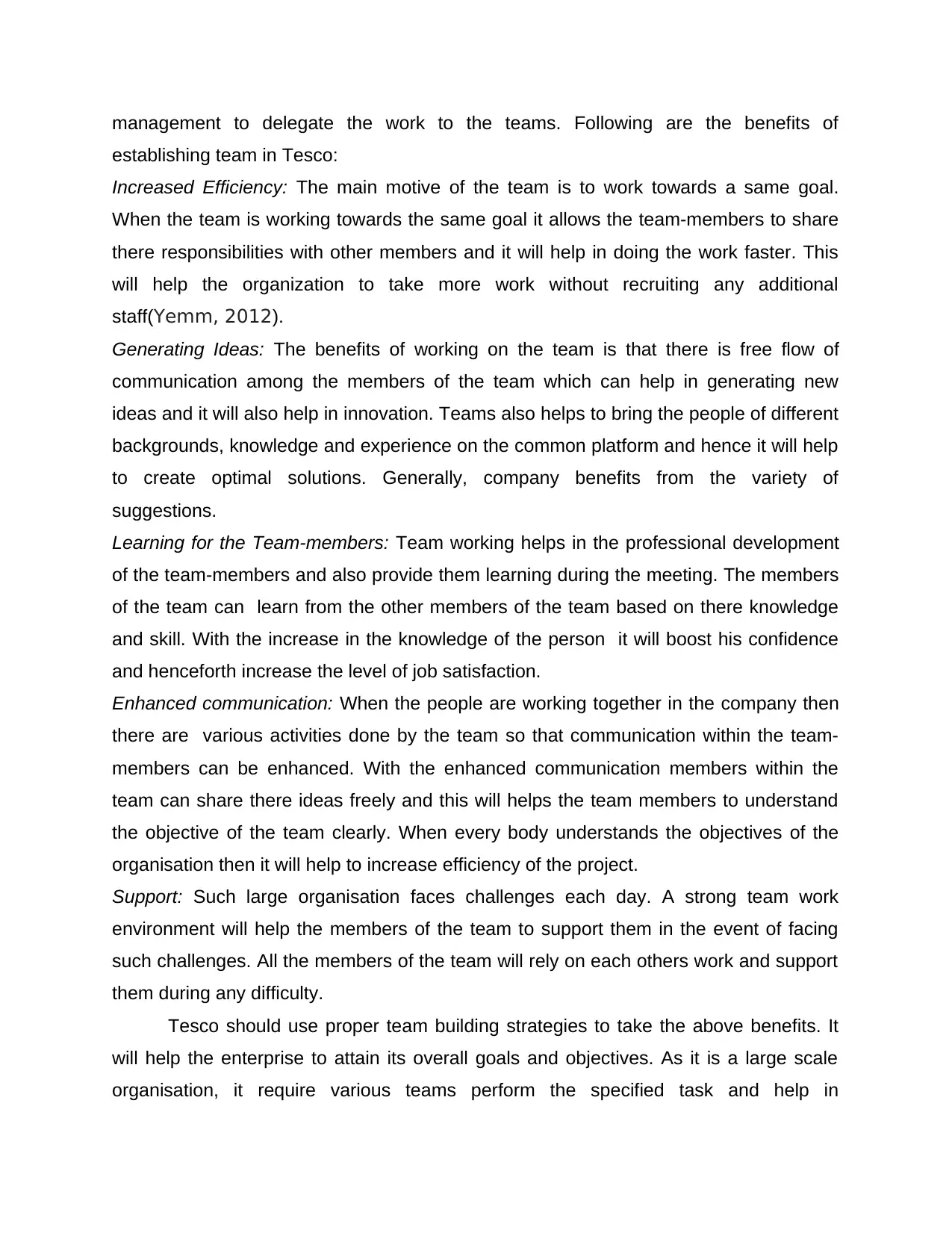
management to delegate the work to the teams. Following are the benefits of
establishing team in Tesco:
Increased Efficiency: The main motive of the team is to work towards a same goal.
When the team is working towards the same goal it allows the team-members to share
there responsibilities with other members and it will help in doing the work faster. This
will help the organization to take more work without recruiting any additional
staff(Yemm, 2012).
Generating Ideas: The benefits of working on the team is that there is free flow of
communication among the members of the team which can help in generating new
ideas and it will also help in innovation. Teams also helps to bring the people of different
backgrounds, knowledge and experience on the common platform and hence it will help
to create optimal solutions. Generally, company benefits from the variety of
suggestions.
Learning for the Team-members: Team working helps in the professional development
of the team-members and also provide them learning during the meeting. The members
of the team can learn from the other members of the team based on there knowledge
and skill. With the increase in the knowledge of the person it will boost his confidence
and henceforth increase the level of job satisfaction.
Enhanced communication: When the people are working together in the company then
there are various activities done by the team so that communication within the team-
members can be enhanced. With the enhanced communication members within the
team can share there ideas freely and this will helps the team members to understand
the objective of the team clearly. When every body understands the objectives of the
organisation then it will help to increase efficiency of the project.
Support: Such large organisation faces challenges each day. A strong team work
environment will help the members of the team to support them in the event of facing
such challenges. All the members of the team will rely on each others work and support
them during any difficulty.
Tesco should use proper team building strategies to take the above benefits. It
will help the enterprise to attain its overall goals and objectives. As it is a large scale
organisation, it require various teams perform the specified task and help in
establishing team in Tesco:
Increased Efficiency: The main motive of the team is to work towards a same goal.
When the team is working towards the same goal it allows the team-members to share
there responsibilities with other members and it will help in doing the work faster. This
will help the organization to take more work without recruiting any additional
staff(Yemm, 2012).
Generating Ideas: The benefits of working on the team is that there is free flow of
communication among the members of the team which can help in generating new
ideas and it will also help in innovation. Teams also helps to bring the people of different
backgrounds, knowledge and experience on the common platform and hence it will help
to create optimal solutions. Generally, company benefits from the variety of
suggestions.
Learning for the Team-members: Team working helps in the professional development
of the team-members and also provide them learning during the meeting. The members
of the team can learn from the other members of the team based on there knowledge
and skill. With the increase in the knowledge of the person it will boost his confidence
and henceforth increase the level of job satisfaction.
Enhanced communication: When the people are working together in the company then
there are various activities done by the team so that communication within the team-
members can be enhanced. With the enhanced communication members within the
team can share there ideas freely and this will helps the team members to understand
the objective of the team clearly. When every body understands the objectives of the
organisation then it will help to increase efficiency of the project.
Support: Such large organisation faces challenges each day. A strong team work
environment will help the members of the team to support them in the event of facing
such challenges. All the members of the team will rely on each others work and support
them during any difficulty.
Tesco should use proper team building strategies to take the above benefits. It
will help the enterprise to attain its overall goals and objectives. As it is a large scale
organisation, it require various teams perform the specified task and help in
⊘ This is a preview!⊘
Do you want full access?
Subscribe today to unlock all pages.

Trusted by 1+ million students worldwide
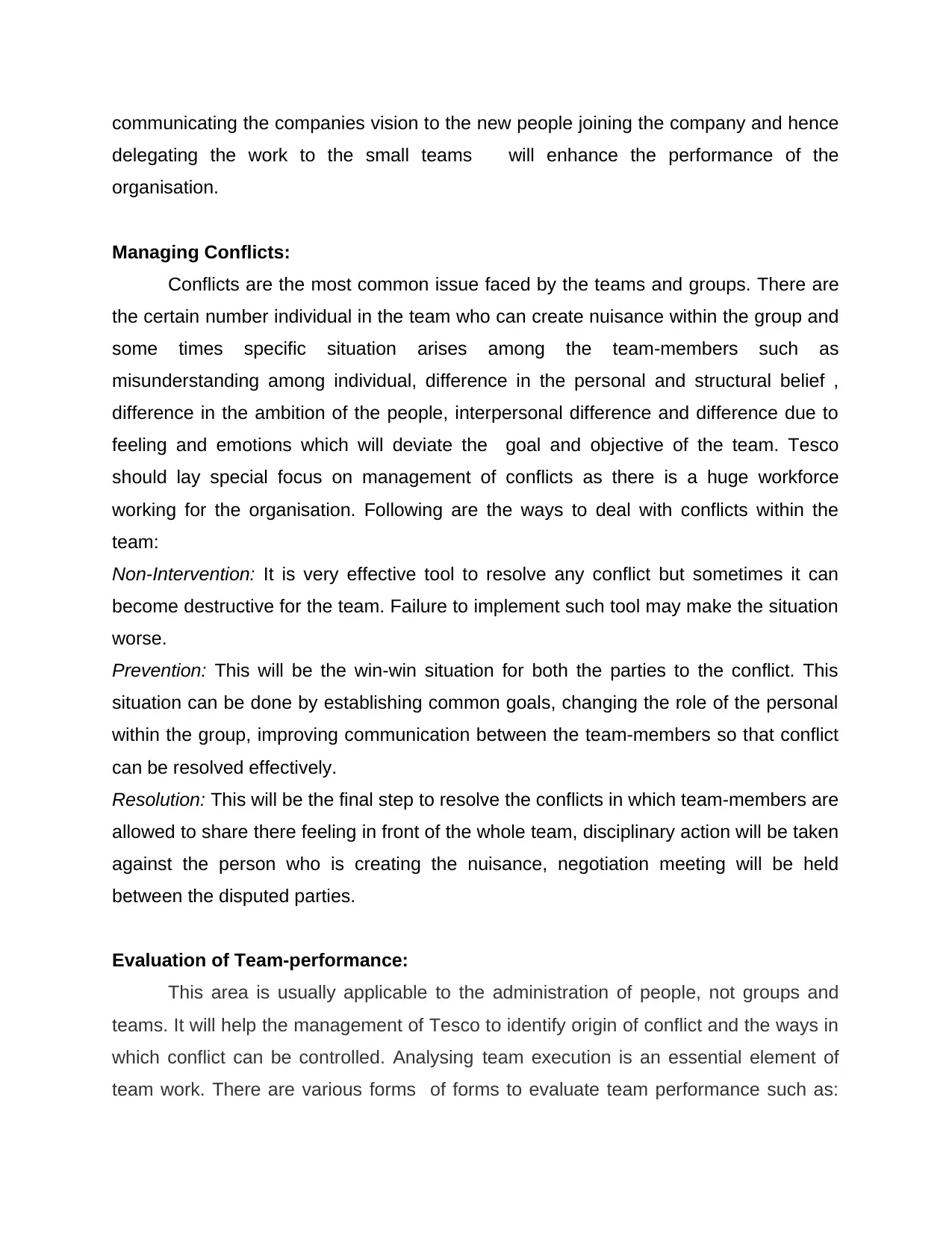
communicating the companies vision to the new people joining the company and hence
delegating the work to the small teams will enhance the performance of the
organisation.
Managing Conflicts:
Conflicts are the most common issue faced by the teams and groups. There are
the certain number individual in the team who can create nuisance within the group and
some times specific situation arises among the team-members such as
misunderstanding among individual, difference in the personal and structural belief ,
difference in the ambition of the people, interpersonal difference and difference due to
feeling and emotions which will deviate the goal and objective of the team. Tesco
should lay special focus on management of conflicts as there is a huge workforce
working for the organisation. Following are the ways to deal with conflicts within the
team:
Non-Intervention: It is very effective tool to resolve any conflict but sometimes it can
become destructive for the team. Failure to implement such tool may make the situation
worse.
Prevention: This will be the win-win situation for both the parties to the conflict. This
situation can be done by establishing common goals, changing the role of the personal
within the group, improving communication between the team-members so that conflict
can be resolved effectively.
Resolution: This will be the final step to resolve the conflicts in which team-members are
allowed to share there feeling in front of the whole team, disciplinary action will be taken
against the person who is creating the nuisance, negotiation meeting will be held
between the disputed parties.
Evaluation of Team-performance:
This area is usually applicable to the administration of people, not groups and
teams. It will help the management of Tesco to identify origin of conflict and the ways in
which conflict can be controlled. Analysing team execution is an essential element of
team work. There are various forms of forms to evaluate team performance such as:
delegating the work to the small teams will enhance the performance of the
organisation.
Managing Conflicts:
Conflicts are the most common issue faced by the teams and groups. There are
the certain number individual in the team who can create nuisance within the group and
some times specific situation arises among the team-members such as
misunderstanding among individual, difference in the personal and structural belief ,
difference in the ambition of the people, interpersonal difference and difference due to
feeling and emotions which will deviate the goal and objective of the team. Tesco
should lay special focus on management of conflicts as there is a huge workforce
working for the organisation. Following are the ways to deal with conflicts within the
team:
Non-Intervention: It is very effective tool to resolve any conflict but sometimes it can
become destructive for the team. Failure to implement such tool may make the situation
worse.
Prevention: This will be the win-win situation for both the parties to the conflict. This
situation can be done by establishing common goals, changing the role of the personal
within the group, improving communication between the team-members so that conflict
can be resolved effectively.
Resolution: This will be the final step to resolve the conflicts in which team-members are
allowed to share there feeling in front of the whole team, disciplinary action will be taken
against the person who is creating the nuisance, negotiation meeting will be held
between the disputed parties.
Evaluation of Team-performance:
This area is usually applicable to the administration of people, not groups and
teams. It will help the management of Tesco to identify origin of conflict and the ways in
which conflict can be controlled. Analysing team execution is an essential element of
team work. There are various forms of forms to evaluate team performance such as:
Paraphrase This Document
Need a fresh take? Get an instant paraphrase of this document with our AI Paraphraser
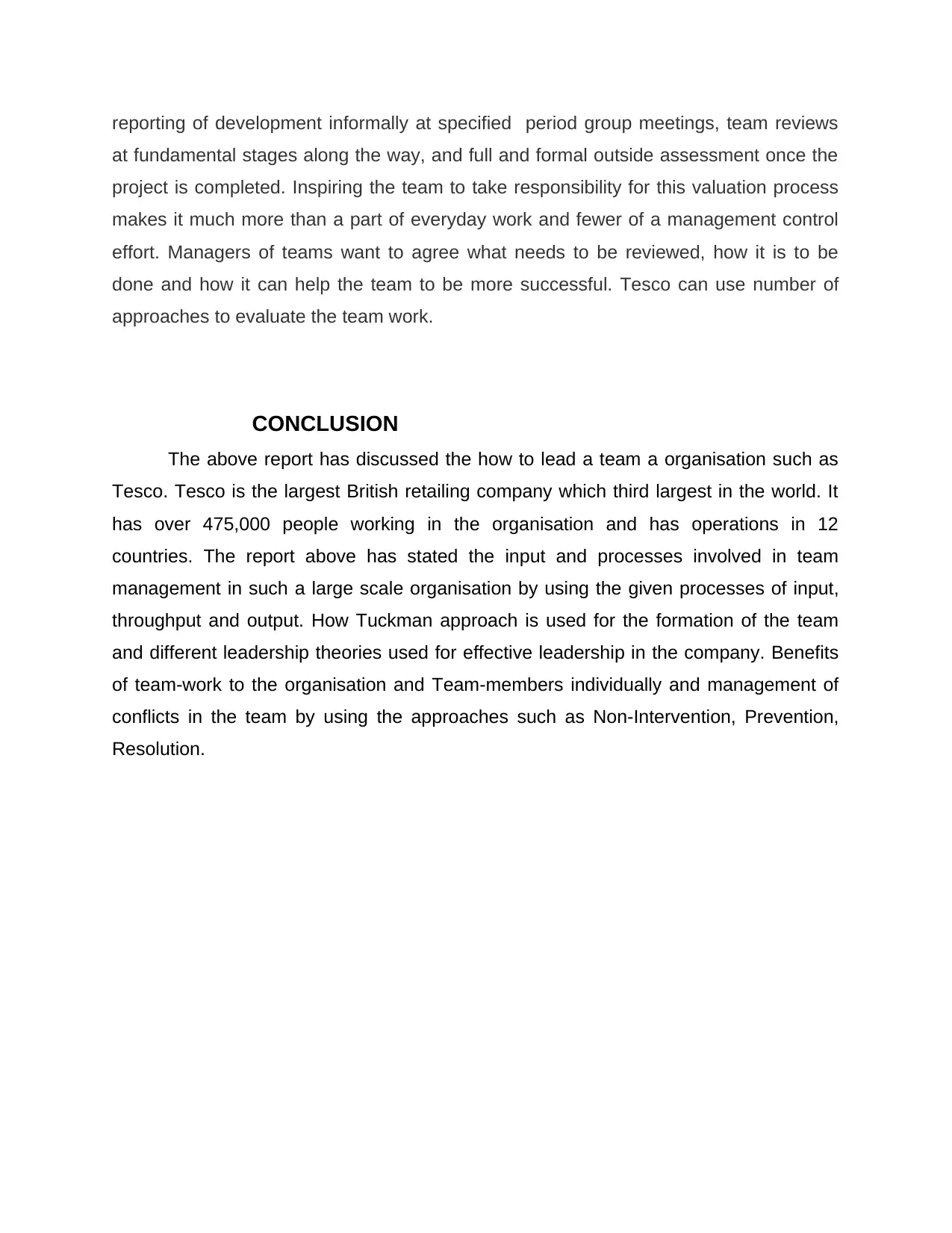
reporting of development informally at specified period group meetings, team reviews
at fundamental stages along the way, and full and formal outside assessment once the
project is completed. Inspiring the team to take responsibility for this valuation process
makes it much more than a part of everyday work and fewer of a management control
effort. Managers of teams want to agree what needs to be reviewed, how it is to be
done and how it can help the team to be more successful. Tesco can use number of
approaches to evaluate the team work.
CONCLUSION
The above report has discussed the how to lead a team a organisation such as
Tesco. Tesco is the largest British retailing company which third largest in the world. It
has over 475,000 people working in the organisation and has operations in 12
countries. The report above has stated the input and processes involved in team
management in such a large scale organisation by using the given processes of input,
throughput and output. How Tuckman approach is used for the formation of the team
and different leadership theories used for effective leadership in the company. Benefits
of team-work to the organisation and Team-members individually and management of
conflicts in the team by using the approaches such as Non-Intervention, Prevention,
Resolution.
at fundamental stages along the way, and full and formal outside assessment once the
project is completed. Inspiring the team to take responsibility for this valuation process
makes it much more than a part of everyday work and fewer of a management control
effort. Managers of teams want to agree what needs to be reviewed, how it is to be
done and how it can help the team to be more successful. Tesco can use number of
approaches to evaluate the team work.
CONCLUSION
The above report has discussed the how to lead a team a organisation such as
Tesco. Tesco is the largest British retailing company which third largest in the world. It
has over 475,000 people working in the organisation and has operations in 12
countries. The report above has stated the input and processes involved in team
management in such a large scale organisation by using the given processes of input,
throughput and output. How Tuckman approach is used for the formation of the team
and different leadership theories used for effective leadership in the company. Benefits
of team-work to the organisation and Team-members individually and management of
conflicts in the team by using the approaches such as Non-Intervention, Prevention,
Resolution.
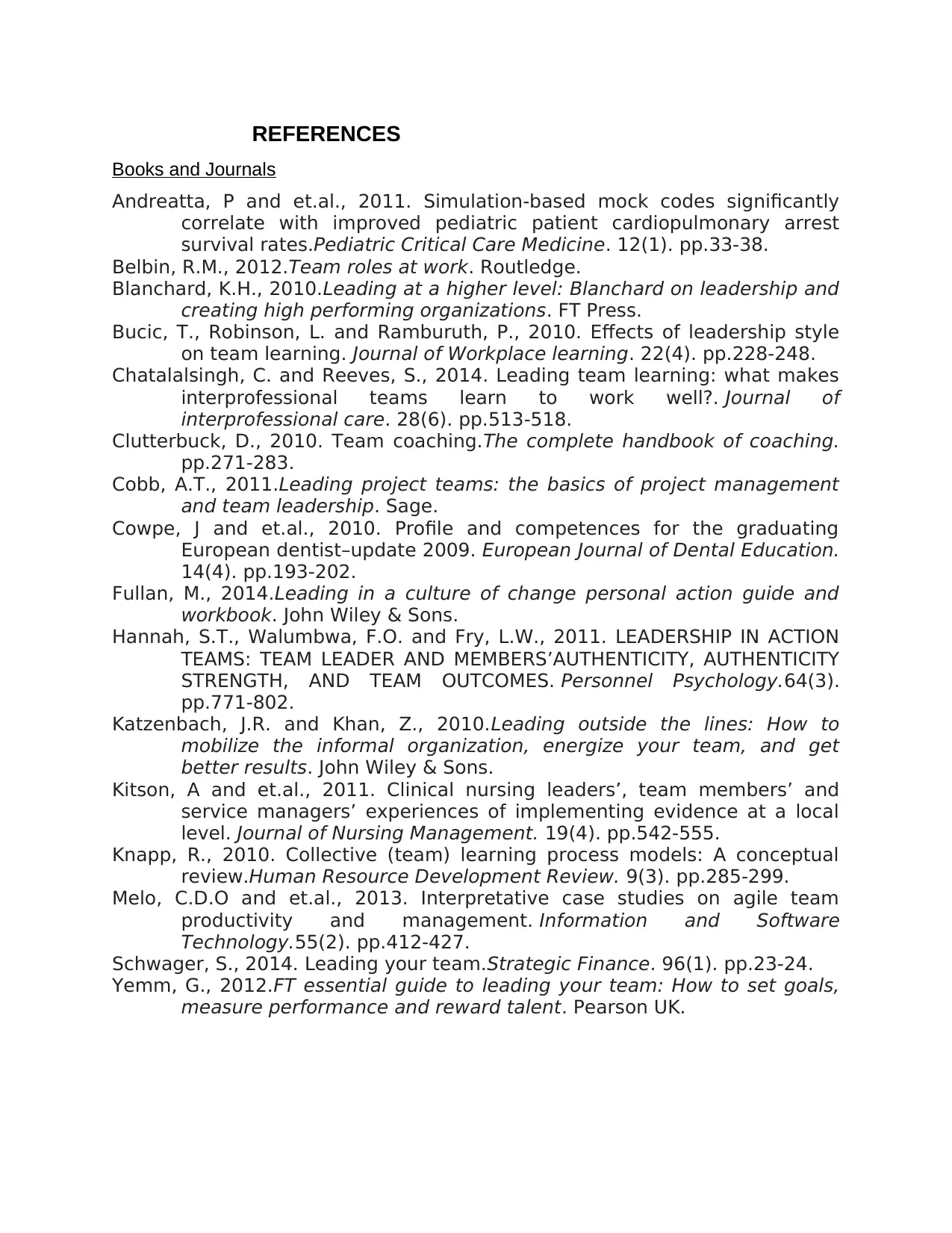
REFERENCES
Books and Journals
Andreatta, P and et.al., 2011. Simulation-based mock codes significantly
correlate with improved pediatric patient cardiopulmonary arrest
survival rates.Pediatric Critical Care Medicine. 12(1). pp.33-38.
Belbin, R.M., 2012.Team roles at work. Routledge.
Blanchard, K.H., 2010.Leading at a higher level: Blanchard on leadership and
creating high performing organizations. FT Press.
Bucic, T., Robinson, L. and Ramburuth, P., 2010. Effects of leadership style
on team learning. Journal of Workplace learning. 22(4). pp.228-248.
Chatalalsingh, C. and Reeves, S., 2014. Leading team learning: what makes
interprofessional teams learn to work well?. Journal of
interprofessional care. 28(6). pp.513-518.
Clutterbuck, D., 2010. Team coaching.The complete handbook of coaching.
pp.271-283.
Cobb, A.T., 2011.Leading project teams: the basics of project management
and team leadership. Sage.
Cowpe, J and et.al., 2010. Profile and competences for the graduating
European dentist–update 2009. European Journal of Dental Education.
14(4). pp.193-202.
Fullan, M., 2014.Leading in a culture of change personal action guide and
workbook. John Wiley & Sons.
Hannah, S.T., Walumbwa, F.O. and Fry, L.W., 2011. LEADERSHIP IN ACTION
TEAMS: TEAM LEADER AND MEMBERS’AUTHENTICITY, AUTHENTICITY
STRENGTH, AND TEAM OUTCOMES. Personnel Psychology.64(3).
pp.771-802.
Katzenbach, J.R. and Khan, Z., 2010.Leading outside the lines: How to
mobilize the informal organization, energize your team, and get
better results. John Wiley & Sons.
Kitson, A and et.al., 2011. Clinical nursing leaders’, team members’ and
service managers’ experiences of implementing evidence at a local
level. Journal of Nursing Management. 19(4). pp.542-555.
Knapp, R., 2010. Collective (team) learning process models: A conceptual
review.Human Resource Development Review. 9(3). pp.285-299.
Melo, C.D.O and et.al., 2013. Interpretative case studies on agile team
productivity and management. Information and Software
Technology.55(2). pp.412-427.
Schwager, S., 2014. Leading your team.Strategic Finance. 96(1). pp.23-24.
Yemm, G., 2012.FT essential guide to leading your team: How to set goals,
measure performance and reward talent. Pearson UK.
Books and Journals
Andreatta, P and et.al., 2011. Simulation-based mock codes significantly
correlate with improved pediatric patient cardiopulmonary arrest
survival rates.Pediatric Critical Care Medicine. 12(1). pp.33-38.
Belbin, R.M., 2012.Team roles at work. Routledge.
Blanchard, K.H., 2010.Leading at a higher level: Blanchard on leadership and
creating high performing organizations. FT Press.
Bucic, T., Robinson, L. and Ramburuth, P., 2010. Effects of leadership style
on team learning. Journal of Workplace learning. 22(4). pp.228-248.
Chatalalsingh, C. and Reeves, S., 2014. Leading team learning: what makes
interprofessional teams learn to work well?. Journal of
interprofessional care. 28(6). pp.513-518.
Clutterbuck, D., 2010. Team coaching.The complete handbook of coaching.
pp.271-283.
Cobb, A.T., 2011.Leading project teams: the basics of project management
and team leadership. Sage.
Cowpe, J and et.al., 2010. Profile and competences for the graduating
European dentist–update 2009. European Journal of Dental Education.
14(4). pp.193-202.
Fullan, M., 2014.Leading in a culture of change personal action guide and
workbook. John Wiley & Sons.
Hannah, S.T., Walumbwa, F.O. and Fry, L.W., 2011. LEADERSHIP IN ACTION
TEAMS: TEAM LEADER AND MEMBERS’AUTHENTICITY, AUTHENTICITY
STRENGTH, AND TEAM OUTCOMES. Personnel Psychology.64(3).
pp.771-802.
Katzenbach, J.R. and Khan, Z., 2010.Leading outside the lines: How to
mobilize the informal organization, energize your team, and get
better results. John Wiley & Sons.
Kitson, A and et.al., 2011. Clinical nursing leaders’, team members’ and
service managers’ experiences of implementing evidence at a local
level. Journal of Nursing Management. 19(4). pp.542-555.
Knapp, R., 2010. Collective (team) learning process models: A conceptual
review.Human Resource Development Review. 9(3). pp.285-299.
Melo, C.D.O and et.al., 2013. Interpretative case studies on agile team
productivity and management. Information and Software
Technology.55(2). pp.412-427.
Schwager, S., 2014. Leading your team.Strategic Finance. 96(1). pp.23-24.
Yemm, G., 2012.FT essential guide to leading your team: How to set goals,
measure performance and reward talent. Pearson UK.
⊘ This is a preview!⊘
Do you want full access?
Subscribe today to unlock all pages.

Trusted by 1+ million students worldwide
1 out of 12
Related Documents
Your All-in-One AI-Powered Toolkit for Academic Success.
+13062052269
info@desklib.com
Available 24*7 on WhatsApp / Email
![[object Object]](/_next/static/media/star-bottom.7253800d.svg)
Unlock your academic potential
Copyright © 2020–2025 A2Z Services. All Rights Reserved. Developed and managed by ZUCOL.





